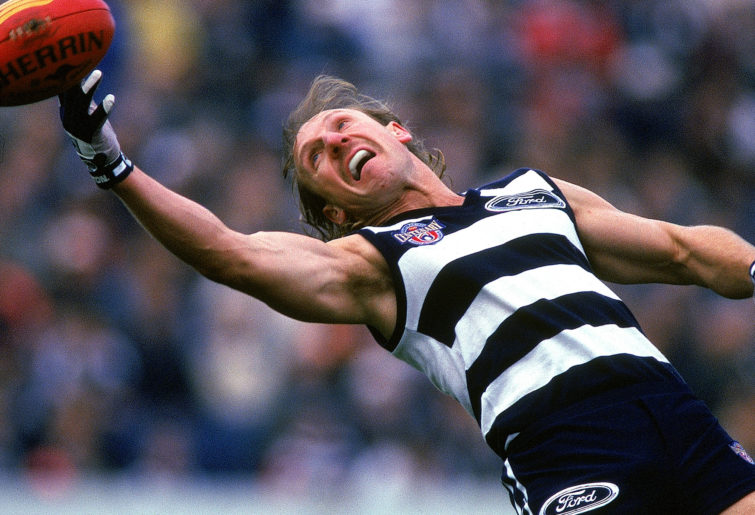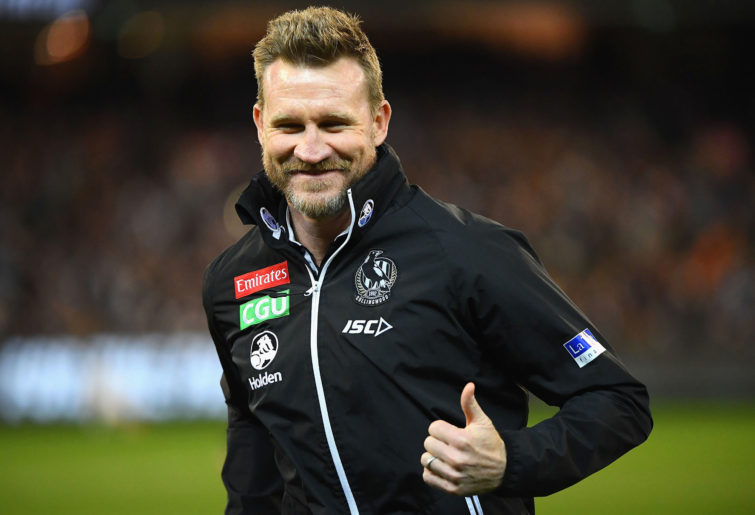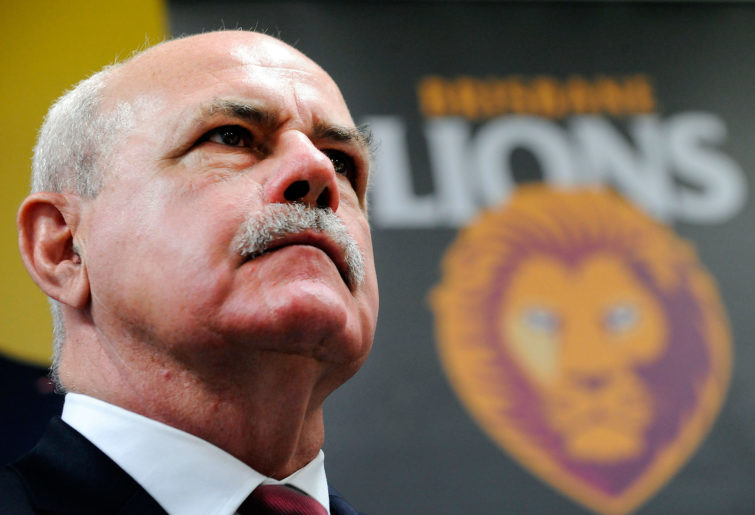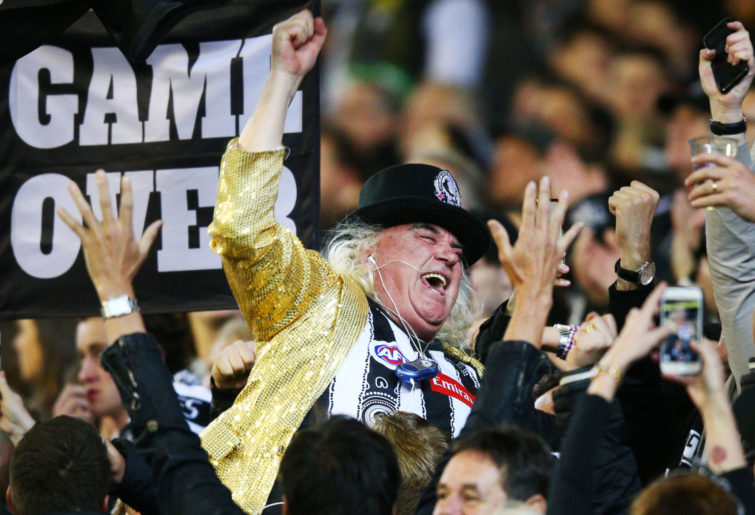Following Part 1, here are the Magpies’ next five infuriating CSM moments that had every Collingwood supporter pulling their hair out.
10. The New Magpies
Collingwood’s administration up to 1983 had always been miserly. They passed on any number of gun trades – such as Bernie Quinlan – because they simply refused to pay for players. They preferred recyclables. Meanwhile, the clubs who could afford it were going on recruiting sprees to get the best talent they could.
Australian rules was changing. It was evolving from this semi-professional, low-paying, part-time gig that equated to a hobby for many into a business and professional sport. Just as some clubs would be slow to adapt to the draft and the salary cap when they came into play, back then some clubs failed to adapt to the game being about spending money to achieve success.
Collingwood was one of those clubs.
Following a disastrous 1982, which saw Collingwood go from grand finalists in 1981 to tenth in a 12-team competition, a ticket rose to challenge the incumbent administration. The New Magpies campaigned on a platform of dragging the club into the 20th century and buying the players they needed to win a flag. Coming off grand final losses in 1977, ’79, ’80 and ’81, the fans were quickly on board.
Well, the New Magpies did buy up big. And randomly. They raided Richmond for stars in Geoff Raines and David Cloke, as well as interstate leagues. There never seemed to be a great logic to the team they were building – it was just whoever they could buy. Their attempt to get an experienced coach in John Kennedy failed, and they ended up with SANFL Port Adelaide coach John Cahill.
Cahill was a legend in the SANFL, but given the assignment Collingwood faced, they needed an experienced and proven VFL coach who could handle the pressures of being at the helm of the bigger club in the country, manage disparate personalities, cobble all these players together cohesively, and play a style suited to the VFL.
There are comments that come the 1983 season, half the list didn’t know each other given the influx of players. Most of them fizzled also. Only a handful – such as David Cloke and Shane Morwood – gave Collingwood great service. And I was always disappointed in the way David Cloke was suddenly abandoned by Leigh Matthews and the club. Cloke ended up going back to Richmond.
Collingwood finished sixth in 1983, and fourth in 1984, winning their way through to the preliminary final before being smashed by eventual premiers Essendon. Cahill decided that was enough and went home. Into the breach stepped Collingwood legend Bob Rose, who seemed more a choice out of desperation than anything. The following year, Leigh Matthews was appointed his assistant, and heir apparent.
However, by 1986, the club was almost bankrupt. The banks recommended they close their doors. Players were asked to take a 20 per cent pay cut. Raines and WA recruit Mike Richardson refused and left, ending up at Essendon. New Magpies president Ranald Macdonald resigned. Treasurer Allan McAllister took over.
The New Magpies were a great concept, but the execution was horrible. The only caveat here is this disaster helped the club find the focus to build the 1990 premiership team.
9. Sacking Peter Daicos
Peter Daicos had a disappointing 1993, injuring his knee in a second-round game against Geelong – in which he kicked eight goals – and then kicking two more the following week against Essendon, before limping off. Collingwood tried to bring him back early and he struggled. He played one pre-season game in 1994, and then was sacked.
Granted, Daicos was in the twilight of his career and at 33, there was a query whether he had anything left to offer. But he had no pace that age could diminish. He retained his best assets – his nous, poise and skills. He probably could’ve nestled in a pocket, popping up to kick a few here and there as small forwards are wont to do.
A few things bothered me about the sacking. Firstly, why not sack him at the end of 1993, rather than wind him up for 1994?
The worst thing about this decision, however, is that just one year later, Leigh Matthews drafted ex-Hawthorn teammate Dermott Brereton. Brereton had been a gun in his prime, but his body had taken a battering as a key forward. He’d struggled at Sydney, and asking him to fill a key position slot at Collingwood at 31 was a big ask.
I have no problem in Collingwood picking up Brereton. Too often, list managers make arbitrary decisions based on age, rather than performance. But if Brereton had proven he could be serviceable as an older forward, why not afford the same opportunity to Peter Daicos?
I could understand if Collingwood had young guns busting down the door for selection, but that wasn’t the case. I could understand if the club was awash in small forwards. They weren’t. In fact, Daicos’ spot on the list was taken by Richmond’s Stephen Ryan. You’re probably thinking, Stephen who? You’re right. Ryan played eight games and that was it.
If you look at Collingwood’s list in 1994, I’m astonished they couldn’t reserve one spot for Daicos in the hopes he could become a regular contributor. Given his talent and experience, he was a better option that most.
Following his sacking, he briefly considered going elsewhere. I wanted Geelong to pick him up. I would’ve watched Geelong games to see Gary Ablett Senior at full forward, and Peter Daicos in the forward pocket.

(Photo by Sean Garnsworthy/Getty Images)
Fitzroy – who often picked up scraps due to their dire financial situation – was the likelier destination. In the end, the fans rallied against the sacking, which convinced Daicos to remain a one-club legend.
As an aside, I also want to make a special mention of Collingwood sacking Mark Williams. Williams had arrived at Collingwood in 1981, won state selection that year, and had been one of their better players in their losing grand final side.
By 1983, new Collingwood coach – and his former SANFL Port Adelaide coach – John Cahill made him captain. In 1984, he led Collingwood’s goal-kicking with 53.31. In 1986, he led the players through the request to take a 20 per cent pay cut.
Williams grew disgruntled when he learnt that he – the club’s captain – was the eighth highest paid player on Collingwood’s list. Collingwood felt Williams was holding them to ransom and sacked him. Allegedly, there was never any conversation between the two.
Williams had barely missed any footy in his six years at Collingwood (just three games) and was definitely one of Collingwood’s better players – especially during that time everything was unravelling.
He was uncompromising on the field, a strong leader, and could play on the ball or forward. He’s one of the toughest players I’ve seen, and would be held in higher regard had his career not being depreciated by his tenure at the fizzling Brisbane Bears.
I thought both Daicos and Williams deserved better – especially given the state of the club when each were discarded.
8. The way Collingwood acquired Nathan Buckley
I loved Nathan Buckley as a player. He doesn’t get the dues he deserves as an elite midfielder. It always shocks me how lowly he’s rated in any lists looking at great players.
In the 1990s, any praise from the media was always qualified by the assertion, “He only stands out because he’s in a bad team.”
It’s funny that when Chris Judd went to Carlton, the same media declared, “He stands out despite being in a poor team.”
For a chunk of his career, Buckley played a lone hand in the midfield, roved to losing ruckmen, was thrown around the field to plug holes (he was once played on Wayne Carey, and beat him), and dealt with taggers during a time they could get away with gutless sniping behind the play.

(Photo by Quinn Rooney/Getty Images)
My issue is how Collingwood picked up Buckley.
In 1991, the Brisbane Bears drafted him through one of its zones. Buckley didn’t want to go to Queensland and challenged the system. His dream was to play in Victoria, given its fanatical dedication to sport. Victorian-based clubs courted him. Brisbane secured Buckley’s services for 1993 and agreed to trade him to the club of his choice at the end of that season. Buckley chose Collingwood.
Collingwood named ten untouchables – players they would not trade to Brisbane. Surely this sends a divisive message through the playing list – that certain players are expendable. How would you feel playing for Collingwood if you weren’t in that top ten list? Or if you thought you would be and you weren’t? Or if your name was casually bandied around as trade fodder?
There were also rumours at the time that the players from the Collingwood premiership team had a pact and they wouldn’t be traded involuntarily, and that securing Buckley broke that pact. Again, this just unsubstantiated rumour.
Brisbane chose two players (1990 premiership hero Craig Starcevich and pacey young rover Troy Lehmann) as well as their first-round draft pick, which ended up being Chris Scott.
I understand you need to pay and sacrifice to make trades happen. But surely all the bartering should’ve been done behind closed doors, rather than publicly where the club’s brains trust are officially labelling three quarters of the list expendable for the acquisition of one player.
7. Appointing Tony Shaw as coach
I loved Tony Shaw as a player. He’s underrated. His kicking mightn’t have been long, but it was always precise. His hand-balling was pinpoint, and despite queries about his pace, he never seemed rushed. People exalted Greg Williams despite similar criteria. I always thought of Shaw as Greg Williams Lite. Shaw was also a terrific on-field leader.
Leigh Matthews coached Collingwood to their drought-breaking premiership in 1990, but by 1993 it was evident that Collingwood were now stagnating – on and off the field. They played a running game that was easily shut down, and their recruiting – which had been so surgical in the lead-up to the 1990 flag – now was haphazard.
Lots of that 1990 flag side also either struggled with injury, or didn’t reproduce to the same level they had in that 1990 season. Tragically, champion winger Darren Millane – such a force behind the 1990 flag, and touted a future captain – had been killed in a drink-driving accident in 1991.
It all felt like it had been coming apart ever since that flag.
At the time, being a 20-something Collingwood cynic, I wanted Matthews replaced at the end of 1993, when the list still had enough potential for a new coach to build upon. Matthews didn’t look like the sort of coach who was going to reinvent himself at Collingwood, or the way he expected Collingwood to play.
He coached Collingwood to a single finals appearance in 1994. Interestingly, 1990 aside, Matthews never coached Collingwood to a finals win in their 1988 (two finals), ’89, ’92, and ’94 campaigns.
Tony Shaw retired at the end of 1994 and he was courted by Carlton for an assistant’s role. Shaw complains then-president John Elliott’s bombastic nature put him off, but to many Collingwood fans at the time it seemed a given Shaw would be Collingwood’s next coach. He was installed as an assistant to Leigh Matthews for 1995.
As an aside, following the close of 1994, Tony Lockett decided to leave St Kilda. Collingwood were one of the clubs who courted him, and apparently a committee vote decided against signing him. At this time, Collingwood had a young Saverio Rocca coming up. I’ve never had a problem with missing out on Tony Lockett. Collingwood fans pine about it to this day, but the club was spectacularly unravelling. Lockett went to a strong, well organised Sydney side, which played finals from 1996 to 1999, and was unable to help them win a flag.
I don’t know what he would’ve done at Collingwood during this time, given the list was questionable, the game plan vulnerable, and the delivery problematic. Given Lockett wanted to get away from the pressures of the footy-fanatical Victorian public and media. I don’t think he would’ve retained his sanity had he come to Collingwood.
Leigh Matthews cites the committee deciding to pass on Lockett as the signpost when he knew his time was up at Collingwood. Collingwood lost the first three games of 1995, drew on that historic Anzac Day against Essendon, and then lost the next two matches. They would win just eight games for the season – their worst return under Matthews since 1987.

It wasn’t long before Leigh Matthews moved to Brisbane. (AAP Image/Dan Peled)
Matthews stepped down and Tony Shaw took over in 1996. Shaw had some good ideas. Drawing from basketball, he played zones – something every club does nowadays. He also stacked the halfback line with guns and drove counter attack from defence – again, something that’s a given nowadays.
But he struggled in other areas – not least of all in championing plodders. Shaw felt because he had transformed himself into a great player from limited materials, he could do that with anybody else.
While Shaw might’ve been limited on-field physically, he wasn’t limited on-field mentally. He could read the play, had tremendous courage, and was a great decision-maker. You can only teach those things to a certain extent. For the best players, it’s instinct.
If Shaw had taken up Carlton’s offer, or gone elsewhere and served a lengthy apprenticeship, he could’ve become a very good coach. He might never have made it back to Collingwood, but neither did Leigh Matthews ever make it back to Hawthorn. Decisions shouldn’t be based on sentimentality.
At the time of Matthews’ departure, Collingwood needed another outsider to come in and do whatever was required to shake up the place – just as Tom Hafey had done in 1977, as Leigh Matthews did in 1986, and Mick Malthouse did in 1999 and 2000. Even if they wanted a Collingwood man back in the job, they should’ve went for somebody who had no connection to the current list, such as Mark Williams. That was another problem with Shaw: he was now coaching players he’d played with, and been close to.
As it was, Collingwood continued to deteriorate and by the end of the decade, they had won their second wooden spoon.
6. Round 24, 2011 – Collingwood versus Geelong
For somebody who’d followed Collingwood for over 30 years up to that point, 2011 was an amazing experience.
I’d seen good Collingwood teams, but nothing like the 2011 squad. The 2010 team started slowly – behind Geelong and St Kilda – but as the season went on, found another gear and accelerated past them.
The 2002 and ’03 sides were grand finalists, but usually ground out wins. The 1990 side was a better team on paper (and often too easily dismissed), but also adopted an extremely defensive attitude – arguably to compensate for the lack of genuine key forwards. Tommy Hafey’s sides were making grand finals, but never a truly dominant team (1977 was as close as they got).
In 2011, Collingwood had the validation of the 2010 flag behind them, and the knowledge they had comfortably accounted for the other contenders in the 2010 finals. They beat St Kilda, West Coast, and Hawthorn easily in home-and-away games.

Joffa donned the jacket on plenty of occasions in 2011. (Photo by Michael Dodge/AFL Media/Getty Images)
Geelong had put a chink in the armour in Round 8, beating Collingwood on a cold Melbourne night, but it wasn’t disastrous. Scott Pendlebury took the advantage late in the game and kicked the goal that would’ve put Collingwood in front, but umpire Shaun Ryan disallowed the advantage. Umpires boss Jeff Gieschen said it should’ve been allowed.
But besides this hiccup, Collingwood motored along for the bulk of the season. Their percentage hovered around 180 per cent. It was a joy to go to game not stressed, and expecting comfortable wins. Even when they looked troubled, they always found another gear.
It is the best, most skilled and dominant Collingwood team I’ve seen in my time following the Pies – and that includes the teams that have come after it, including the 2018 team.
Going into the final round, Collingwood played Geelong – the two favourites for the flag. Collingwood couldn’t move from top spot. Geelong could drop to third if they lost, and if Hawthorn beat Gold Coast by an unrealistic margin.
Collingwood had two options. One, they could rest half the team before going into the finals. If Geelong beat them – or smashed them – it would always be qualified by Collingwood’s omissions. Two, Collingwood could try to make a statement against Geelong, and develop a mental edge over them.
They did neither. They played as if they had their attention fixed on the finals. They did this also in the final round of 2010, but fortunately played a club in Hawthorn who adopted a similar attitude.
It was Geelong who went out there to make a statement, smashing Collingwood by 96 points. It gave the Cats a psychological stranglehold over the Pies. To top it off, Collingwood incurred several injuries.
This game at the time convinced me that Collingwood were done for 2011. The last month had unravelled into a spate of injuries, questions about the succession plan, coach Mick Malthouse making noise about leaving, and a loss of general focus.
However majestically the team had cruised through the bulk of the season, they were now spluttering, with no sign of a tune-up. The Cats smelled vulnerability and capitalised.
Good on them for not taking anything for granted, and for identifying the need to wound their opponent – their likeliest rival for the 2011 flag – going into the finals.
They did. Mortally.
































































































